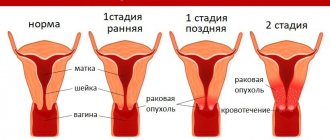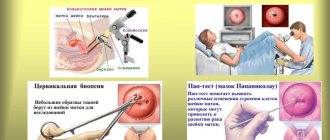Classification
According to the dynamics of the process (stages), the following forms of erosion are distinguished:
- progressive;
- stationary;
- healing.
A description of each stage (type) is presented below.
Congenital and acquired
Congenital erosion (ectopia of columnar epithelium) is the presence of columnar epithelial tissue outside the cervical canal, which appears in the prenatal period.
They are most often noted in childhood and adolescence and usually undergo regression without special therapy until puberty.
The erosion is round or irregular in shape, bright red in color, and has a smooth surface. When conducting a study of pathological discharge, as well as signs of inflammation, no signs were noted.
If the disappearance of erosion does not occur before puberty, then infection may enter from the outside, causing inflammation with further adverse consequences. It is extremely rare that flat condylomas may occur. Treatment is not carried out, they are subject to observation.
Acquired erosion is a pathological condition that is characterized by damage and subsequent desquamation of the stratified squamous epithelium of the vaginal part of the cervix. The result is an injured surface with signs of inflammation. The most common cause of this condition is endocervicitis - inflammation of the cervical canal mucosa.
Erosion is localized around the external os , most often on the posterior lip of the cervix. The color and shape do not differ from those of congenital, bleeding is possible when touched by a gynecological probe.
True and false
True erosion is a process similar to acquired erosion, characterized by the same signs, manifestations and principles of therapy.
Important! True erosion is classified as a short-term process, since its duration is no more than 2 weeks. Subsequently, it passes into the next stage - pseudo-erosion.
Pseudo-erosion is changes that form during a further pathological process, the basis of which was true erosion. The damaged multilayered squamous epithelial tissue is replaced by cylindrical tissue, which creeps onto the altered mucous membrane of the cervical canal. If there are no pathological processes, then this phenomenon is called ectopia.
The main reason for its appearance is inflammatory pathology. Endocrine disruption, which occurs in parallel with inflammation, promotes development and impairs their healing.
If the following signs are noted during pseudo-erosion, then they speak of a pre-tumor condition:
resistance to treatment;
- often recur;
- long duration of flow;
- there is cell atypia on microscopic examination.
The principles of therapy for both erosions and pseudo-erosions include:
- therapy is carried out in parallel with the treatment of pathologies that can cause their occurrence, for example, endocervicitis, endometritis, vaginitis;
- in the course of the disease with an inflammatory reaction, the pathogen is determined and appropriate treatment is prescribed;
- if the inflammation is pronounced in the tissues, then therapy is carried out using gentle methods (for example, using sea buckthorn or vaseline oil);
- the use of physiotherapy (irradiation with UV rays, SMV therapy) is recommended;
- destruction of pathological foci (diathermocoagulation, cryodestruction, laser irradiation).
Cervical ectopia with cervicitis
Cervical ectopia with chronic cervicitis - what is it? Cervicitis is an inflammation that occurs in the mucous membrane of the cervix. If this pathological process continues for a long time, then they speak of chronic cervicitis. As a result of this, hypertrophy of the mucous membrane occurs - the proliferation of cylindrical epithelium - it extends beyond the cervical canal. The result is church ectopia with chronic cervicitis.
Clinical picture:
- hyperemia of the mucous membrane;
- the appearance of pathological discharge (change in color, smell, blood);
- pain in the lower abdomen;
- drowsiness, weakness, impaired performance;
- dyspareunia (painful sexual intercourse).
Treatment:
- ectopia therapy;
- treatment of cervicitis (etiotropic therapy, restoration of microflora, correction of immune status).
Chronic
If in the body of an adult woman there is a violation of the ratio of sex hormones (progesterone or androgens), their excess in the vaginal part of the cervical canal, then areas represented by glandular epithelium appear. This condition is commonly called endocervicosis. If these disorders appear over a long period of time or therapy was not prescribed on time, then this is called chronic endocervicosis.
This form is most often asymptomatic; sometimes discharge is possible that was not previously noted.
Causes:
- during the healing of true erosions of inflammatory origin;
- with scarring of mucosal damage that occurs during childbirth;
- hormone imbalance.
Simple
Simple endocervicosis - what does it mean and when does it appear? Time of occurrence is the intrauterine period with possible persistence up to 24 years in nulliparous women. It is the result of exposure to maternal estrogen during the prenatal period.
Small in size, the borders are not blurred, scarlet in color. The girl must be observed by an obstetrician-gynecologist with mandatory diagnostic procedures once every six months. A biopsy (taking a piece of tissue for microscopic examination) is not indicated. Therapy with oral contraceptives (Yarina, Logest) is carried out.
Stationary
Stationary endocervicosis - what is it? Stationary endocervicosis is a situation similar to simple endocervicosis.
This type of pathology indicates a resting stage. That is, the tissue defect does not heal, but does not increase in size. Achieved by normalizing hormonal levels.
Progressive (proliferating)
Progressive (proliferating) endocervicosis is characterized by an increase in the number of reserve cells , which occurs with the formation of new glands in the vaginal part of the cervix.
Types of lesions
Pathology is divided into two main forms - true and false , and the latter - pseudo-erosion - is also divided into congenital and acquired forms.
With true erosion, damage appears in the external os of the uterus, as well as scaly peeling and peeling (desquamation) of epithelial tissue.
Factors leading to the progression of the pathology are inflammatory lesions of the female genital organs, as well as their mechanical or other damage.
In medical practice, true damage is quite rare ; it is detected during a gynecological examination in the form of foci of inflammation in the subepithelial connective tissues, swelling of the cervix, and blood on its damaged surface.
The treatment of the true form is the fight against the pathological processes that caused the erosion, and provided that treatment is started in a timely manner, there will be no need for treatment of the mucosal damage itself.
Rapid suppression of inflammatory processes will lead to healing of the epithelium in up to 1-2 weeks, otherwise the true lesion turns into a state of pseudo-erosion.
Pseudo-erosion of the cervix can be congenital (developing as a result of hormonal imbalance during intrauterine development of the fetus, caused by an increased amount of production of the hormone estrogen) and acquired (arising due to inflammatory lesions of the genital tract, sexually transmitted diseases, mechanical injuries to the genital organs, immune and hormonal imbalances).
The congenital form is divided into ectopia and ectropion - the first is the intersection of cylindrical epithelial cells with the natural border in the area of the cervical pharynx and penetration into the epithelial tissue.
With ectropion (a fairly rare pathology), the so-called eversion of the mucous membrane occurs, which makes it a complication of ectopia.
Visually, congenital lesions are round spots of bright red color, irregular in shape and not accompanied by symptoms of the inflammatory process.
In extremely rare cases, this form requires medical treatment, but most often disappears on its own.
Acquired pseudo-erosion develops in several stages - progressive, stationary and epidermal.
Signs of the first are the formation of glandular structures in the cervix (in particular, on its surface and in depth) and their growth into glandular ducts.
The stationary phase is a state of rest with the cessation of formation of formations in the uterus and the absence of an increase in the size of pseudo-erosion.
At this stage, the healing process has not yet occurred, but examination shows that the cervix has a smooth surface of a healthy color without symptoms of inflammation.
the epidermization phase the process of reverse development of pseudo-erosion, during which the pathology can be completely cured provided that the reserve cells formed during the stationary stage stimulate an increase in the number of multilayer epithelial cells and displace the columnar epithelium.
Acquired pseudo-erosion, with successful elimination of the factors that originally caused this problem, disappears on its own; in cases of complications, treatment with instrumental methods is used.
What is ectropion of the cervix:
Definition and principles of disease development
A pathological violation of the integrity of the epithelium or the vaginal area of the cervix as a whole is called its erosion (ICD-10 code - N86, name of the disease - erosion and ectropion of the cervix).
Many women are diagnosed - more than 50% face this problem. Moreover, many of them have no idea about the disease until it is discovered during a visit to the gynecologist.
Modern medicine does not have accurate data on the causes of erosion.
The most common theories include:
- the disease is a consequence of the development of inflammatory lesions of the genitourinary system (for example, endocervicitis), due to which the work of the glands in the epithelial layer increases;
- ulcerations develop as an inflammatory process due to damage to the genital organs with strong mechanical impact (for example, during rough sexual intercourse or due to the use of instruments during difficult childbirth);
- the disease develops against the background of sexually transmitted infections - infection with Candida fungi, chlamydia, human papillomavirus, genital herpes viruses.
Erosion is more likely to occur in women who begin sexual activity early.
Often accompanying an act of sexual intimacy, mechanical damage and infections lead to problems with the integrity of the immature mucous membrane (and it matures only by the age of 20-22).
The reasons for the occurrence and progression of erosion are different , including not only the listed factors, but also decreased immunity and hormonal imbalances.
The forms of manifestation of pathology are also different. Cervical erosion - causes, symptoms and treatment:
https://youtu.be/5_E9YK7RN70
Symptoms
Typically, cervical erosion is not accompanied by severe symptoms. However, sometimes, both with true and false erosion, vaginal discharge and pain in the lower abdomen may be observed. Often, spotting is detected after sexual intercourse, so-called “contact” bleeding. A gynecologist may suspect erosion already during the first gynecological examination in the speculum. Clarification of the diagnosis requires the use of a special optical preparation - a colposcope. Colposcopy can be simple or extended, using special preparations (mainly iodine preparations). The detection of a bright red spot around the external os of the cervix indicates ectopia. The further diagnostic program involves taking smears, as well as a biopsy - removing a piece of pathologically altered epithelium for examination.
PATHOGENESIS
The pathogenesis of cervical ectopia has not been sufficiently studied.
In the prenatal period, the process of displacement of the columnar epithelium beyond the internal os is considered a normal stage of development of the cervix. As a rule, when a woman reaches reproductive age, the border between columnar and stratified squamous epithelium is not visible during a gynecological examination. However, ectopia can persist in early reproductive age, especially in women with menstrual irregularities (against the background of relative hyperestrogenism).
Women with symptoms of cervical cancer need to be seen urgently, within two weeks of referral. Andy Gorensky University of Rome G. Table Causes of postcoital bleeding. You were probably called a colposcopy because of an abnormal smear test. It is difficult to be sure from your letter what was found during the colposcopy.
The term ectopic simply means at a site different from where the structure is usually found, and it is unlikely that this is what the specialist said. You most likely said that you have “erosion” of the cervix. Erosion is a general term used to describe a harmless condition that is often, but not always, associated with taking the pill or pregnancy.
Cervical ectopia is considered a congenital, usually temporary, physiological condition; they are not dangerous in relation to malignancy and do not require treatment.
The formation of acquired ectopia of the cervix occurs under the influence of endogenous and exogenous etiological factors, which include mechanisms that support the pathological differentiation of reserve cells of the cervix into the cylindrical epithelium.
It usually doesn't cause any symptoms, but it can cause bleeding after sex or heavy vaginal discharge. Erosion can make it difficult to sample the two different cells that need to be seen in the smear. This may be the reason for your abnormal smear test result.
Having an erosion does not increase your risk of developing cervical cancer, and treatment is usually only recommended if the erosion is causing symptoms such as bleeding or excessive discharge. He or she will be able to look at the letter from the hospital and explain to you what was found and what, if anything, needs to be done.
Risk factors and groups
1. Disorders of hormonal hemostasis. 2. Early onset of sexual activity (before 15 years). 3. Early birth (before 16 years). 4. Conditions of the cervix before pregnancy (ectopia). 5. Frequent change of sexual partners. 6. Old cervical ruptures with a deformed, scarred cervix. 7. Chronic inflammatory diseases of the cervix of specific and nonspecific etiology. 8. Frequent relapses of inflammatory diseases of the cervix of specific and nonspecific etiology. 9. Women who have previously undergone treatment of the vaginal part of the cervix without prior in-depth examination. 10. Professional factors: mining, oil refining, aluminum industries. 11. History of abortion.
The danger of combined pathology
One of the types of cervical erosion is a combined pathology - cervical ectopia of the cervix with chronic cervicitis, what is it? This form develops under the influence of the following reasons:
- viral infection (most often human papillomavirus);
- bacterial infections (sexually transmitted diseases, especially chlamydia);
- inflammatory processes in the organs of the genitourinary system (the list includes vulvitis, vaginitis and colpitis);
- imbalance of vaginal microflora (mainly due to insufficient hygiene or incorrect use of antibiotics);
- hormonal disorders with increased estrogen levels;
- concomitant pathologies (mainly related to the organs of the urinary system).
Often, cervical ectopia itself leads to chronic cervicitis - with this pathology, columnar cells that replace squamous epithelial cells in the cervix are vulnerable to destruction, which makes the organ vulnerable even to the relatively safe microflora that lives in the vagina.
Against this background, the development of cervicitis - inflammation of the mucous membrane in the cervical canal - can be expected quite soon.
What to do to avoid the development of ectopia
Prevention of the development of cervical ectopia is based on the following principles:
- It is necessary to promptly identify and treat inflammatory processes of the genital organs.
- Prevent changes in hormonal levels by getting rid of stress factors.
- Maintain immunity by treating chronic infections, introducing an active, healthy lifestyle, balanced nutrition, and eating high-quality and fortified foods.
- Have one regular sexual partner.
- Avoiding abortions that damage the reproductive system.
- The disease does not pose any danger to life, so the prognosis for cervical ectopia is favorable.
Attention! This article is posted for informational purposes only and under no circumstances constitutes scientific material or medical advice and should not serve as a substitute for an in-person consultation with a professional physician. For diagnostics, diagnosis and treatment, contact qualified doctors!
Causes of endocervicosis in different groups of women
Experts believe that various factors can cause the development of ectopia of the columnar epithelium of the cervical canal.
The most common reasons:
- Congenital pathology . In this case, the atypical arrangement of epithelial cells was established during the formation of the organism.
- Infectious process . Often the development of sexually transmitted infections that cause damage to the mucous membrane leads to the development of pathology. The most dangerous are chlamydia, gonorrhea, streptococcal infection and gardnerella, the human papillomavirus.
- Inflammatory process of various etiologies. This causes an exacerbation of the disease.
- Injuries to the vaginal epithelium . Injuries themselves do not cause ectopia, but they can provoke inflammation or infection, which in turn cause ectopia.
- Dysbacteriosis of the vaginal microflora can also provoke an infectious infection;
- Hormonal disorders . Against the background of hormonal imbalance, the likelihood of disease develops.
- Early sexual life . Full maturation of the epithelium of the vaginal mucosa is completed only by the age of 20; before this age it is very vulnerable to infections, so early sexual activity almost always leads to pseudo-erosion.
- Immunity . Weakening of local and systemic immunity of the body.
- Promiscuous sex life . Frequent change of sexual partners and unprotected sexual intercourse.
CLASSIFICATION OF ECTOPIA
In the modern colposcopic nomenclature adopted at the VII International Congress in Rome (1990), ectopia (cylindrical epithelium) is classified as point I: “normal findings of colposcopic examination.” The absence of cervical ectopia as a pathology in ICD-10 and its classification as normal data in colposcopic nomenclature implies uncomplicated forms of cervical ectopia, which are a physiological condition.
Why are you interested in this disease?
Perhaps due to gynecology, oncology, colposcopy and cervical pathology services are not necessarily integrated into most healthcare settings. The National Institute of Hygiene and Health Care says that women with postcoital bleeding should undergo a complete pelvic examination, including a contemplation examination, by a primary care provider, and those patients who have clinical signs suspicious for cervical cancer, you should urgently contact secondary care.
Treatment of cervical erosion
Treatment of cervical erosion can be medicinal and surgical. Surgical treatment of cervical erosion, currently used, consists of influencing the affected area using laser, radio wave surgery or cryodestruction. These are painless and bloodless methods for treating cervical erosion, which give excellent results and have virtually no complications. Laser and radio wave surgery also have the advantage that they have a stimulating effect on tissue regeneration.
Previously used as a treatment for cervical erosion, the diathermocoagulation method is not currently used due to pain and the fact that it leads to the formation of scar tissue, which subsequently prevents the dilatation of the cervix during childbirth. The method of chemical destruction of erosion is also not currently used due to insufficient precision of exposure and the risk of damage to healthy tissue.
Drug treatment of cervical erosion consists of the use of anti-inflammatory drugs aimed at eliminating urogenital infections, restorative and immunostimulating agents. If endocrine pathology is detected, it is corrected with synthetic hormonal drugs, analogues of female sex hormones. For this purpose, the latest generation of contraceptive hormonal drugs are used, which are devoid of most side effects. Physiotherapeutic treatment of cervical erosion shows good results. Physiotherapy means (magnetic therapy, ultraviolet irradiation, UHF, microwave, laser therapy, etc.) can have a significant anti-inflammatory and healing-stimulating effect on tissue damaged by erosion.
Cervical endometriosis (code - N80.8)
Endometriosis of the cervix is more often observed after diathermocoagulation (carried out without taking into account the phase of the menstrual cycle), after plastic surgery on the cervix, after supravaginal amputation of the uterus and after childbirth. This is the only site of endometriosis that usually exists separately.
In some cases, the patient does not complain, and the diagnosis is established by examining the cervix in a speculum or during colposcopy. In other cases, the complaint is pre- and postmenstrual spotting. If endometriosis is localized only in the vaginal part of the cervix, pain does not occur. When endometrioid heterotopias grow into the cervical canal or when it is combined with other localizations, nagging pain in the lower abdomen occurs, changing its intensity during the cycle, pain during sexual activity (dyspareunia).
Foci of endometriosis appear as bluish cysts, or as bleeding linear or dotted areas. The release of blood from endometriotic lesions during and after menstruation is of decisive importance.
Treatment. If an infectious agent is detected, etiotropic therapy, sanitation of the vagina followed by surgical treatment: emptying of the endometriotic lesion, radio wave coagulation (laser vaporization) of the cervix. When endometriosis is combined with cicatricial deformation of the cervix - radio wave conization.
Endocervicosis is another name for pseudo-erosion
Pseudo-erosion of the cervix has another medical name – endocervicosis. Being the most common lesion of the gynecological sphere, this disease under this name is divided into several varieties:
- simple endocervicosis , what is it: without neoplasms, without any symptoms, easily detected upon examination, but capable of causing further development of inflammation in the mucous membrane;
- chronic endocervicosis of the cervix is an asymptomatic disease (in most cases), which develops in the absence of treatment of the acute form, when progressive inflammation moves to the fibers of connective and muscle tissue;
- progressive endocervicosis - glandular erosion with neoplasms of glandular structures, clearly visible when examining the cervix.
According to the phases of development, endocervicosis is divided into:
- stationary endocervicosis of the cervix, what is it: with ulcers that do not progress, but do not heal, in which glandular formations are released, but excessive cell proliferation does not appear;
- proliferating – endocervicosis with abundant growth of glandular cells and the formation of new glands, as a result of which the focus of pseudo-erosion of the cervix rapidly increases in size;
- epidermizing , what is it: healing endocervicosis with epidermization, beginning either due to the ingrowth of stratified squamous epithelium from the “reserves” around the source of erosion into the formed glandular tissue, or with the development of squamous epithelial cells under the columnar epithelium that has penetrated the cervix with its subsequent replacement.
Treatment of endocervicosis usually includes the use of drugs that suppress the activity of the underlying diseases, for which antibacterial drugs are primarily used.
Find out more about the disease:
- can it go away on its own or develop into cancer;
- what is the clinical picture;
- symptoms of erosion and ectopia;
- what kind of discharge is there, can it hurt or bleed;
- what is the danger and what are the consequences of the disease.
Cervicitis (code - N72)
Acute cervicitis. It is observed during infection with gonococci, postpartum infection (streptococci and staphylococci), and viral infection. The early stages of the inflammatory process are characterized by vascular congestion, exudative phenomena, and infiltration of neutrophilic granulocytes. Dystrophic changes are observed in epithelial cells. Necrosis causes ulceration (cervical erosion), the presence of purulent or serous-purulent exudate on the surface of the exocervix. The reparative process is accompanied by the development of granulation tissue, the appearance on the surface of a layer of cylindrical or immature metaplastic cells, which, as they proliferate and differentiate, form multilayered squamous epithelium.
Chronic cervicitis. Characteristic manifestations are infiltration of subepithelial tissue with lymphocytes and plasma cells, vascular congestion. In the epithelium of the cervix, along with dystrophic changes, processes of proliferation and hyperplasia of cells, squamous metaplasia are observed. Such changes in the exocervix should be distinguished from cervical intraepithelial neoplasia; they disappear after anti-inflammatory therapy.
The most common cause of chronic cervicitis is infection with chlamydia, HPV, and mycoplasmas. Almost every second woman with chronic cervicitis has microbial associations, which indicates the need for mandatory bacteriological testing to determine the effectiveness of pathogenetic treatment.
Treatment of exo- and endocervicitis is complex, including etiotropic therapy, elimination of predisposing factors, and treatment of concomitant diseases. After therapy, 30 days later, control of cure using PCR. After 2 months - control colposcopy. If changes in the cervix persist, destructive treatment methods are indicated: laser vaporization, argon plasma or radio wave coagulation of the cervix. When chronic cervicitis is combined with ectropion or cicatricial deformation of the cervix - radio wave conization of the cervix.
Diagnostics
Diagnosis of cervical erosion is often difficult due to the absence of characteristic complaints from the patient or the asymptomatic course of the disease. Changes in the subjective state are usually caused by a disease that causes the development of erosion. Therefore, the main diagnostic methods are visual examination of the cervix in mirrors and colposcopy, which allows a detailed examination of the pathological focus under multiple magnification. The extended colposcopy method is used if malignancy of cervical erosion is suspected. The erosion zone is treated with a 5% alcohol solution of iodine and examined under a colposcope. True erosion (pseudo-erosion) is light pink, the dysplasia zone is yellow, and atypical lesions are white. If areas of erosion that are questionable for dysplasia are detected, a targeted biopsy of the cervix is performed with histological analysis of the resulting tissue.
The essence of pathology
What is cervical ectopia? It is necessary to imagine the structure of the epithelium of this organ. The uterine cervix has a vaginal part, consisting of flat cells, as well as, the surface of which is lined with cylindrical cells. Pathology occurs when the second type of tissue moves to the outer area of the cervix and replaces the squamous epithelium. Upon examination, this is revealed as a bright scarlet spot in the part of the external pharynx of the uterine cervix; in contrast to true erosion, no damage to the layer is observed.
In the area of pseudo-erosion, one can notice a “transformation zone”, where, with the help of reserve cells, the reverse process of replacing the cylindrical metaplastic squamous epithelium of varying degrees of maturity occurs. This indicates the healing of pseudo-erosion, but this process can be interrupted, and a relapse occurs. As a result of the closure of metaplastic tissues of the glands, Nabothian cysts of the uterine cervix are formed.
Cervical erosion
Colposcopy of the cervix - how is the procedure performed and how to prepare for it?
Treatment
Treatment of ectropion of the cervix consists of its destruction or removal, elimination of the concomitant inflammatory process with subsequent correction of the anatomy of the cervix and vaginal microflora and is aimed at restoring the barrier and reproductive functions of the uterine pharynx, preventing pretumor and tumor processes in the endocervix. Clinical gynecology approaches the choice of treatment method for cervical ectropion individually, depending on the age, condition of the patient’s reproductive system and identified colposcopic and cytological changes. Surgical treatment of cervical ectropion includes destructive methods (diathermocoagulation, laser vaporization, cryodestruction) and surgical methods (radio wave conization or excision of the cervix). Destructive methods of treating ectropion are indicated for moderately severe deformation of the cervix and allow the destruction of pathological tissue. Surgical methods make it possible to conduct a morphological study of removed samples. Congenital ectropion of the cervix is destroyed by cryodestruction, and if ineffective, surgical treatment is used. Radioconization or radioexcision is performed in cases of severe ectropion, the presence of dysplasia and other precancerous processes and allows the removal of the affected fragment of the cervix and part of the cervical canal. Drug therapy is also prescribed, used in the treatment of cervical ectopia and including antibacterial, antiviral, hormonal, and immunomodulatory drugs. In case of significant deformation of the cervix due to ruptures and scar processes, reconstructive plastic surgery is performed. During the rehabilitation period after surgical treatment of cervical ectropion, sexual rest for the first 4-6 weeks, limiting physical activity, prohibiting douching, using hygienic tampons, taking baths, visiting a bathhouse, sauna, and swimming pool are recommended.
SYMPTOMS AND CLINICAL PICTURE OF CERVICAL ECTOPY
The diagnosis of congenital ectopia of the cervix is established upon the first visit to the gynecologist of a woman who has recently begun sexual activity.
When diagnosing acquired cervical ectopia, its appearance on a previously unchanged cervix is taken into account.
Colposcopic manifestations of early recurrent ectopia of the cervix are detected 2–3 months after treatment, late - after 6 or more months. Early recurrent cervical ectopia is considered a consequence of inadequate treatment. However, if this is an uncomplicated form, is it worth talking about relapse and inadequacy of therapy?
Periodic torture in childhood and neurological malformation disease. Description of a clinical case. Guido La Placa, Massimo Andreotti, Claudio Pradella, Roberto Besana. Subsequent examinations will determine the need for surgical intervention for suboccipital decompression. A tummy tuck is a clinical presentation characterized by the head being lifted off on one side with the chin turned in the opposite direction. Neck pain is not a disease, but a symptom of many underlying pathophysiological processes.
We describe a recurring case of relapse in a 10-year-old girl. The history highlights the occurrence of approximately 5 years of headaches in headaches and recurrent episodes of torsion with a frequency of approximately 3-4 annual episodes. The throat is always characterized by deviation of the head to the left with severe pain to active and passive movements of the neck. In most cases, there was never an obvious triggering event, otherwise symptoms arose after physical exertion. Usually residual clinical and neurological objectivity.
The uncomplicated form of cervical ectopia does not have specific clinical manifestations, and is most often diagnosed during a preventive gynecological examination.
A complicated form of cervical ectopia is observed in more than 80% of cases. In a complicated form, ectopia is combined with inflammatory, precancerous processes of the cervix. When combined with a violation of the epithelial-stromal relationship of the cervix, ectopia of the cervix is interpreted as ectropion. In the presence of concomitant inflammatory processes of the lower genital tract, patients complain of leucorrhoea, itching, dyspareunia, and rarely contact bleeding. Often the reason for contacting a gynecologist is menstrual irregularities and infertility.
Indications for hospitalization
Normal hematochemical studies, radiography of the cervical spine and dental arches. Nothing abnormal for orthopedic and ophthalmic evaluation. Vertebrate metamorphs are generally aligned with the rectilinear physiology of cervical lordosis. The girl is treated with anti-inflammatory and muscle relaxants, which leads to resolution of symptoms. Discussion: Torture outside the neonatal period is quite common and the vast majority of cases recognize minor cervical trauma or inflammation of the cervical muscles due to pathologies of the first respiratory tract.
Additional facts
Ectropion is considered in gynecology as a complicated clinical form of cervical ectopia, combining pseudo-erosion and cicatricial deformation. Cervical ectropion usually affects the lower part of the uterus and can be a congenital or acquired (post-traumatic) disease. The mucous membrane of the cervical canal (endocervix), in contrast to the surface of the vaginal part of the cervix (exocervix), is represented by columnar epithelium, the cells of which secrete a mucous secretion. With ectropion of the cervix, the endocervix from its inherent alkaline environment enters the acidic environment of the vaginal contents, which disrupts the physiological secretion of the cervical glands and the barrier functions of the cervix, which are important for the prevention of infections and the reproductive process. Cervical ectropion leads to the penetration of vaginal microflora into the mucous membrane of the cervical canal and the development of the inflammatory process. Most often, cervical ectropion is accompanied by endocervicitis, cervicitis, and endometritis. The presence of chronic inflammation with cervical ectropion creates conditions for the development of other pathological conditions: true erosion, dysplasia, leukoplakia, atrophy of the cervical epithelium and cervical cancer.
EPIDEMIOLOGY
Cervical ectopia is detected in 38.8% of the female population and 49% of gynecological patients. The congenital form of cervical ectopia (including ectropion) is observed in 11.3% of women with this pathology. The maximum incidence (more than 50%) of the incidence of cervical ectopia is observed in nulliparous women under 25 years of age.
Postcoital bleeding, colposcopy, cervical cancer. Postcoital bleeding refers to spotting or bleeding that occurs after sexual intercourse and is not associated with menstruation. Symptom prevalence rates range from 7 to 0%, with one report of an annual cumulative incidence of 6% among menstruating women. In women under 35 years of age, the most important reason for exclusion is chlamydial infection, while in women over 35 years of age it is cervical cancer.
Postcoital bleeding is usually caused by cervical or endometrial polyps, cervicitis due to chlamydia or gonorrhea, and vaginitis associated with trichomoniasis or candidiasis. Endometritis in the presence of an intrauterine contraceptive device can sometimes cause postcoital bleeding. This symptom is rarely caused by cervical intraepithelial neoplasia.
Medical services
Consultation with specialists:
- Obstetrician-gynecologist
- Therapist
- Anesthesiologist-Reanimotologist
Diagnostic procedures:
- General (clinical) urine analysis
- Electrocardiogram registration
- Transvaginal ultrasound examination of the uterus and appendages
- Pathological and anatomical examination of biopsy (surgical) material of the cervix
- Cervical biopsy
- X-ray of the lungs
- Study of coagulation hemostasis
Laboratory diagnostics:
- Microscopic examination of vaginal smears
- Definition of main groups according to the AB0 system
- Determination of antigen D of the Rhesus system (Rh factor)
- Carrying out the Wasserman reaction (RW)
- Determination of antigen (HbsAg) of the hepatitis B virus in the blood
- Determination of antibodies to the hepatitis C virus in the blood
- Determination of antibodies of classes M, G (IgM, IgG) to the human immunodeficiency virus HIV-1 (Human immunodeficiency virus HIV 1) in the blood
- Determination of antibodies of classes M, G (IgM, IgG) to the human immunodeficiency virus HIV-2 (Human immunodeficiency virus HIV 2) in the blood
Description
Ectropion of the cervix.
A pathological condition of the cervix, in which there is an inversion of the mucous membrane of the cervical canal into the vaginal cavity. Clinical manifestations of ectropion develop with the addition of an inflammatory or precancerous lesion of the cervix: this can be leucorrhoea, contact bleeding, menstrual dysfunction, and pelvic pain. Cervical ectropion is diagnosed as a result of a gynecological examination, extended colposcopy, cytological and morphological examination. Treatment of ectropion for congenital or minor lesions may include electrocoagulation, laser vaporization and cryodestruction; with pronounced changes - conization or excision of the cervix.
Sources
- https://im-healthy.online/zabolevaniya/ginekologiya/eshm/vse-vidy.html
- https://beautyladi.ru/vidy-erozii-shejki-matki/
- https://kiberis.ru/?p=22399
- https://diseases.medelement.com/disease/%D1%8D%D1%80%D0%BE%D0%B7%D0%B8%D1%8F-%D0%B8-%D1%8D%D0%BA %D1%82%D1%80%D0%BE%D0%BF%D0%B8%D0%BE%D0%BD-%D1%88%D0%B5%D0%B9%D0%BA%D0%B8- %D0%BC%D0%B0%D1%82%D0%BA%D0%B8/12936
- https://im-healthy.online/zabolevaniya/ginekologiya/eshm/psevdoeroziya.html
- https://tvoyginekolog.online/fonovye-zabolevaniya/mkb-eroziya-shejki-matki.html
- https://kiberis.ru/?p=30490
- https://kiberis.ru/?p=30482
[collapse]
Cervicitis and pregnancy
Cervicitis of the cervix during pregnancy can result in unpleasant consequences not only for the expectant mother, but also for her baby. The disease often causes spontaneous miscarriage and premature birth. Another serious complication is purulent damage to the skin and internal organs of the child in the very first days of his life.
This disease is especially dangerous in the early stages of pregnancy if it is associated with other infectious processes. Fetal infection is usually diagnosed in the first trimester. This can lead to the most unexpected consequences, ranging from intrauterine death to congenital deformities.
A pregnant woman is usually prescribed treatment with antiviral and antibacterial agents. The issue of preserving the fetus is decided individually after a screening examination.








